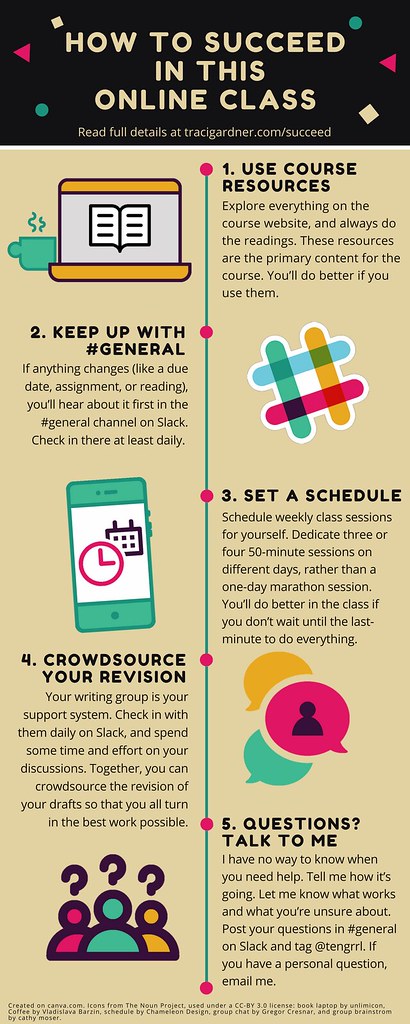-
About
Our Story
back- Our Mission
- Our Leadership
- Accessibility
- Careers
- Diversity, Equity, Inclusion
- Learning Science
- Sustainability
Our Solutions
back
-
Community
Community
back- Newsroom
- Discussions
- Webinars on Demand
- Digital Community
- The Institute at Macmillan Learning
- English Community
- Psychology Community
- History Community
- Communication Community
- College Success Community
- Economics Community
- Institutional Solutions Community
- Nutrition Community
- Lab Solutions Community
- STEM Community
- Newsroom
- Macmillan Community
- :
- English Community
- :
- Bits Blog
- :
- Converting to a More Visual Text to Increase Stude...
Converting to a More Visual Text to Increase Student Success
- Subscribe to RSS Feed
- Mark as New
- Mark as Read
- Bookmark
- Subscribe
- Printer Friendly Page
- Report Inappropriate Content
 This week, I want to talk about why I developed the infographic on the right by converting the related webpage that provides more details. As we came to the peer review for the first major project in my online courses this term, I asked students to post their drafts in a discussion forum early in the week so that their writing groups could provide feedback by the end of the week. The weekly activity points checklist reinforced this timeline, asking them to provide links to their own draft and to their feedback to the members of their groups on Friday. In an ideal world, this structure would give them the weekend to revise their projects, which were due the next week.
This week, I want to talk about why I developed the infographic on the right by converting the related webpage that provides more details. As we came to the peer review for the first major project in my online courses this term, I asked students to post their drafts in a discussion forum early in the week so that their writing groups could provide feedback by the end of the week. The weekly activity points checklist reinforced this timeline, asking them to provide links to their own draft and to their feedback to the members of their groups on Friday. In an ideal world, this structure would give them the weekend to revise their projects, which were due the next week.
Unfortunately, my classes don’t take place in an ideal world. Rather than following the plan that I intended, most students waited until Friday to post anything. Those who posted earlier on Friday then sent me frustrated email messages complaining that no one had posted drafts so they had nothing to respond to. I asked them to wait it out until later in the day. At the very last minute (of course), there was a flurry of activity with students posting drafts and giving one another generic, cursory feedback—“Good job.” “Nice work.” “Looks great.”
Um, how about “Not exactly what I’m looking for”? I know online courses work differently from face-to-face courses, but many students misunderstand the differences. They frequently underestimate the work that goes into an online writing course and the time management skills required. Many students assume that they can simply fit an online course in whenever they have time. The problem is that their other classes, their jobs, and their social and professional obligations tend to have set schedules. Students often run out of time and realize that they never did get to their online course work. They end up rushed as they try to complete all the work at the last minute.
Essentially, I need to help students understand that to succeed in an online writing course, they need to focus on consistent, regular interaction—with the course materials, with their writing group, and with me. That’s where this infographic comes in. I wanted to explicitly tell students what they need to do to succeed in my courses.
I began by writing out a list of ten that explained my tips for success, but the more I looked at it, the more it seemed in conflict with the ideas I wrote about last week in my post on Infographics as Readings. I was presenting students with a flat page of text. Sure, there is some bold text and a numbered list, but all in all, it's a boring page of text. I wanted to convert that information to the short, fast-paced style students are so familiar with in online texts to increase the likelihood that they would read and adopt the information. I narrowed the list, combined the similar ideas, and arranged the details into the infographic.
By applying the same ideas that I used when I converted to a more visual syllabus and began using Infographics as Readings, I hope students will be more successful when we begin the next peer review project. What do you think? Is the infographic more likely to convince students than the original page of tips? I would love to hear what you think in the comments below.
Credits: Infographic was created on canva.com. Icons are all from The Noun Project, used under a CC-BY 3.0 license: : book laptop by unlimicon, Coffee by Vladislava Barzin, schedule by Chameleon Design, group chat by Gregor Cresnar, and group brainstorm by cathy moser.
You must be a registered user to add a comment. If you've already registered, sign in. Otherwise, register and sign in.






